 |
| WALLPAPER: PARACHUTE ELK HAIR CADDIS |
.. The variations are simple: elk hair tail, peacock herl body, poly yarn wing, furnace hackle parachute, no head. Works fine.
 |
| WALLPAPER: ELK HAIR CADDIS |
A Few Flies That Work Well In Yellowstone
 |
| WALLPAPER: PARACHUTE ELK HAIR CADDIS |
 |
| WALLPAPER: ELK HAIR CADDIS |

.. This pattern, the original Feather Duster, is a staple in our Spring assortment. There has been much discussion about the original pattern; so here it is.
.. This old fly gained surprising popularity soon after Bob Bates described it in the Outdoor Press, (August 26, 1993). It was developed in the early 70's and has garnered a following of dedicated nymph fishermen.
.. The original article is hard to find, so we have reproduced it here.
"WALLY'S FEATHER DUSTER".. Eagle's Store in West Yellowstone, MT is just a block and a half from Yellowstone National park west entrance. They stock a lot of things that you need but can't find in the gift-shop-type stores around West Yellowstone. As always it was the fly shop section that interested me most. Beside a normal collection of fishing paraphernalia and good information, they had a set of pictures showing how to build a Feather Duster.
.. The name was bestowed because Wally Eagle, who developed it in the early 70's, used ostrich herl from a feather duster for early copies. (Please do not confuse it with similarly named flies, such as the English dry pattern.) Wally's Feather Duster catches a lot of fish around West Yellowstone and should prove equally successful elsewhere in our northwestern region. Wally provided additional tying details and fishing techniques and a sample fly to photograph.
.. Wally recommends fishing it dead drift with a yarn strike indicator. Any strange movement of the indicator might mean a strike so tighten up a little. You'll know instantly if it is a fish or the bottom. To place an indicator, simply tie an overhand knot in the leader and put a piece of yarn inside the loop. Carry a safety pin to open the knot and change it's position. For fishing the Madison River, place your indicator about 3 - 4 feet above the fly and add a split shot, if needed. On spring creeks, place a sheep's wool indicator only 18 - 20 inches above the fly. The sheep's wool indicator should be as small as possible. Wally uses a chartreuse idicator for good light conditions, but finds it hard to see in some conditions. He recommends using pink or green indicators in bad light conditions.
-- Hook: Mustad 9672, 10 - 18 -- Thread: Burnt orange 3.0 -- Weight: Lead wire -- Underbody: Gray wool -- Tail: Pheasant tail fibers -- Rib: Copper wire -- Body and thorax: Ostrich herl, dark gray -- Wingcase: Pheasant tail fibers
.. Put about five wraps of lead wire around the shank where the thorax will be. Just keep it back from the eye three or four eye widths, so you will have plenty of room for other materials. Use a lead wire that is about equal to the hook wire diameter. Attach your tying thread and wrap over the the lead a couple of times to secure it. Bring the tying thread rearward and attach a strand of wool. Wrap the wool to make an underbody fot the ostrich herl and shape the thorax; the wool also makes a soft base for the pheasant tail fibers. As with the lead wire, leave plenty of room for a head.
.. Use 6 or so pheasant tail fibers for the tail, attach them at the bend and make the tail about a gap width long. Also just in front of the bend secure a copper wire and 5 or 6 ostrich herls. Attach the herls by the tips if you want to taper the body and by the butts if you want a full body. Carry herls forward to mid shank or 2/5ths point depending on if you want a longer or shorter thorax, secure and trim. Counter wind copper wire ribbing, secure and trim.
.. Then right in front of body, tie in 8 to 10 pheasant tail fibers with the butts forward. Leave about a shank length of tips facing rearward. Wrap over butts, bring thread back to tie in point, fold butts back and secure. Attach several ostrich herls for thorax, wrap thread forward, wrap herls forward, secure and trim. Be sure to leave plenty of space for the head. Bring pheasant tail butts forward. secure and trim. Pull tips forward, secure with one or two thread wraps and bend tips back on each side for legs. Legs should extend along the body, ending short of the point. If there are too many legs just trim off a few. Finish the head with a whip finish. Wally doesn't use thread cement because he feels that it lets the Turle knot slip.
.. Pheasant tail is fairly delicate and breaks when big fish chew on it. Extra layers on Wally's Feather Duster wing case give you the opportunity to clip off broken fibers and still have a neat looking wing case.
.. Note: on flies 16 and smaller, Wally's tiers might use partridge instead of pheasant tail for tail, wing case, and legs.
{{{ This fly has fans as far away as Argentina! Go to: Fly Fishing Caribe & Patagonia. }}}
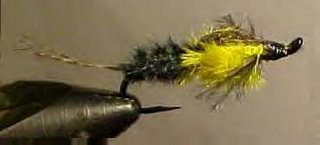 .. In the last 15 years the dry fly has taken control of fly fishing. If you enjoy it keep doing it. If you want to catch more fish try this fly.
.. In the last 15 years the dry fly has taken control of fly fishing. If you enjoy it keep doing it. If you want to catch more fish try this fly.
.. This is a "Feather Duster" variant and has been dubbed the "Montana Duster." The original Feather Duster was perfected by long-time West Yellowstone resident Wally Eagle. He is a member of the family that founded the town. His original flies used the ostrich herl from feather dusters in the family store. The original fly is still excellent for taking large and finicky trout on a regular basis.
 .. This variant is spectacular in the spring, summer & fall. It appeared on the scene about three years ago in the arsenal of knowledgeable guides in Yellowstone Park, and on the streams surrounding the park.
.. This variant is spectacular in the spring, summer & fall. It appeared on the scene about three years ago in the arsenal of knowledgeable guides in Yellowstone Park, and on the streams surrounding the park.
.. It's origin is shrouded in mystery and the originator is currently unknown. We found it on the web: http://hometown.aol.com/guyser1/myhomepage/index.html
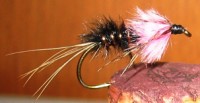 .. Look for this fly to appear in the catalogs and on the shelves of fly shops within the next two - three years. Get ahead of the curve and use it now.
.. Look for this fly to appear in the catalogs and on the shelves of fly shops within the next two - three years. Get ahead of the curve and use it now.
 The yellow color is most popular. However, about this time each year the pink makes an appearance - probably taken for an egg - who knows? Sizes: 6 - 18.
The yellow color is most popular. However, about this time each year the pink makes an appearance - probably taken for an egg - who knows? Sizes: 6 - 18.
Proportions and tying instructions mostly follow the original recipe.
Ingredients for "MONTANA DUSTER": Tail = 3-4 partridge rump fibers, Body = black ostrich herl counter-wrapped with heavy copper wire, Wing Case = pheasant tail fibers (pulled forward and used as legs too), Thorax = yellow or pink ostrich herl. Sizes: 4 - 8, or 2-1xl - 16-3xl.

This little darling is a sure-fire fish getter in just about any color you choose to use. It's quick and easy, it floats like a cork, it's made from common materials, it can be tied in a variety of sizes. And it's a cinch to tie.
For those of you, (myself included,) that like to tie at stream-side, this is the one! It can even be done without a vise and with only a bit of practice. The smaller sizes may need a bit more practice without a vise, but not much. Down to size 12 - 14 should not be too much trouble. If that is a problem, tie a bunch of the smaller ones at home and the bigger ones on the stream.
Ingredients for YELLOWSTONE CINCH: Tail: fine hair from a moose, (ears or inside the legs), Body: floss to match the bugs d'Jour, Wing: elk hair of appropriate size, Head: more floss, Sizes: 4 -18, standard or up to 2xl dry fly hook. Start by tying in the tail and wing together - flat along the body. Wrap the thread loosely to form the body. Tie in the floss, (olive, yellow, gray, green, black, brown, etc.,) in front of the wing root. Wrap the floss forward, then back to the tail, then back to the wing. Wrap the floss forward and backward on either side of the wing while spreading the wing perpendicular to the shank of the hook, (this is the easy part without a vise - just squeeze the wing and wrap.) When the body has the taper necessary, wrap forward and tie off with a finger whip. Some folks like to use black thread, others use thread the color of the floss.
Use plenty of flotant - grease if you prefer, and send it into the stream with a "plop." My kind of fly!

.. The occasional day in early Spring that allows a good hatch is an unanticipated joy. The fish are seldom very selective, (well - sort'a,) and this fly works wonders. Sizes: 10 - 18.
---------
.. It was a late night in the loft in Ennis, Montana. We had fished Beartrap, and the Madison near the islands - way below Norris. The sky was broken clouds and their shadows came and went on the water.
.. Some people call them 'Millers,' others call them moths. What ever they were, there was a scad-pile of them. A famous fishing guide said that he had the fly to match the hatch. We paused as he pawed through his kit and found two of them.
..
"Yellowstone Coachman," he cried and bit off the midge that he had been fishing. He shared his second fly with me, and we returned to the battle. Splash it down, float it in like a gossamer ghost - or anything in between. Fish raced to gather it up. Once I watched three fish dash from under a rock to get to the fly. This was magic... We fished 'til almost dark and hooked every fish in that mile of the Madison - all 4,500 of them - or so it seemed! We drove back to Ennis, arm weary and bone tired. The road was dry, the sky was orange, the company was great. We stopped at the Town Pump for some fuel, and some other fuel.
.. As we sat in the loft and discussed the day we had to learn more about the Yellowstone Coachman. Our guide explained that he had gotten the fly from an old fisherman in West Yellowstone, Montana.
.. He took it just to be kind to the old duffer; put it in his kit and forgot about it. Last year on opening day in Yellowstone Park he saw some 'millers' on the water and remembered the fly. He put it on as a lark and caught a few fish. Ever since then he brings it out in the early spring when the 'millers' are on the water.
----------------
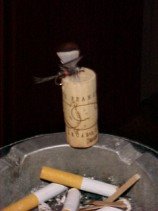 .. This fly is a variant of the fan-wing coachman, The tail is longer and the hackle is softer and larger.
.. This fly is a variant of the fan-wing coachman, The tail is longer and the hackle is softer and larger.
Ingredients for Yellowstone Coachman:
Tail = 3 or 4 peacock sword fibers, Body = peacock herl wound in middle with bright orange floss, Wings = barred chucker. Hackle = grade 3, or stiff hen - one size larger than hook, Head = black thread. Hook Sizes = 6 -14 regular dry fly. Drench with flotant and fish low in the film, or even submerged. Cast gently - it can twirl and sing by your ear and this is hard on the leader and your knots, (and maybe your ear.)
.. The last time I put a fly up, I got many emails about the set-up for photography, and questions about doing it. .. There is no secret, and the pictures are certainly not art. Look at the photo on the left for details. French wine seems to work best. * Use good hackle for the tail,
* Tie it Fat & Fuzzy,
* Rough up the wings,
* Rough up the hackle,
* Float it low in the film,
* Catch Fish.
* Use good hackle for the tail,
* Tie it Fat & Fuzzy,
* Rough up the wings,
* Rough up the hackle,
* Float it low in the film,
* Catch Fish.
 .. Yellowstone Spruce Fly:
.. Yellowstone Spruce Fly:
.. This fly was developed by some neighbors that use a bubble on a spinning or casting rig for Fall fishing. It is an exceptional fly when casted with a fly rod in the spring. It's a bit gaudy for many of our purists, but with a nice slow presentation in the cold waters of the early Spring it looks like a big sack of groceries to hungry trout. Sizes: 4 - 12.
.. It's not really a Spruce Fly, but it works as good as a Dark Spruce Fly in the fall, and better than a Light Spruce Fly in the Spring. It's quick to tie, durable, and well suited to Yellowstone waters.
.. This fly is a medium sized streamer developed by a group of West Yellowstone fishermen who can't afford a BMW or a $700 fly rod but love to fly fish.
 Looks Strange,
Fishes Well.
The "Yellowstone Winter Grub," is reminiscent of steelhead flies used around Salmon, & Chalis, Idaho in the early season. Later they will switch to leeches and buggers, we will switch to the "Yellowstone Duster."
Both Messrs Barnes & Brooks fished this fly, but seldom mentioned it. It has been in the fly boxes of locals for at least 30 years, and gets less attention than it deserves. It is heavy, needs no split shot, has internal action, and catches fish.
Looks Strange,
Fishes Well.
The "Yellowstone Winter Grub," is reminiscent of steelhead flies used around Salmon, & Chalis, Idaho in the early season. Later they will switch to leeches and buggers, we will switch to the "Yellowstone Duster."
Both Messrs Barnes & Brooks fished this fly, but seldom mentioned it. It has been in the fly boxes of locals for at least 30 years, and gets less attention than it deserves. It is heavy, needs no split shot, has internal action, and catches fish.
Recipe for "Yellowstone Winter Grub:"
.. Fish the fly in classic steelhead fashion; controlled casts, loose swing for 1/2 the drift then tighten up and let the fly swing all the way to the bank. Most takes are at the very end of the swing. However, this time of year the action of the fly may induce early takes as well.
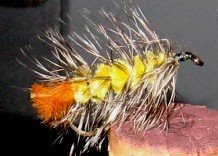 .. Woolly Worm: Spit the words out of your mouth if you must - it's a great Spring fly in Yellowstone country. Sometimes we use small ones on the surface when the snow flies are out. Black or yellow seem to be the colors of choice, we've got more yellow ones. Sizes: 10 - 18.
.. Woolly Worm: Spit the words out of your mouth if you must - it's a great Spring fly in Yellowstone country. Sometimes we use small ones on the surface when the snow flies are out. Black or yellow seem to be the colors of choice, we've got more yellow ones. Sizes: 10 - 18.
 .. Yellowstone Badger: This prickly little devil is one that serves a multitude of purposes. Float it, sink it, splash it, strip it, or just dap it - it is a winner. This fly is similar to the other nymphs that are popular around here - the Pheasant Tail, and the Hare's Ear. We use them all, but keep coming back to this one. Sizes: 12 - 18.
.. Yellowstone Badger: This prickly little devil is one that serves a multitude of purposes. Float it, sink it, splash it, strip it, or just dap it - it is a winner. This fly is similar to the other nymphs that are popular around here - the Pheasant Tail, and the Hare's Ear. We use them all, but keep coming back to this one. Sizes: 12 - 18.
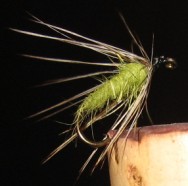 .. Stiff Hackle Nymph: This variant of the soft hackle variety is not a favorite among many folks in the fly fishing community. It does work and it is used by some of our 'more mature' neighbors. We've used it since the 80's and found it to be a useful resource - but we tend to forget it too. This is an all season fly that we just put in the fly box because we have them. Sizes 12 -18.
.. Stiff Hackle Nymph: This variant of the soft hackle variety is not a favorite among many folks in the fly fishing community. It does work and it is used by some of our 'more mature' neighbors. We've used it since the 80's and found it to be a useful resource - but we tend to forget it too. This is an all season fly that we just put in the fly box because we have them. Sizes 12 -18.
 .. Deer Hair Caddis: This little fly we borrowed from Jason Neuswanger over at The Trout Nut. We fished it all last year along with the local versions and it was a standout performer. It's a dark fly that is consistent with some of our early Caddis hatches and we like it very much. Sizes: 10 - 18.
.. Deer Hair Caddis: This little fly we borrowed from Jason Neuswanger over at The Trout Nut. We fished it all last year along with the local versions and it was a standout performer. It's a dark fly that is consistent with some of our early Caddis hatches and we like it very much. Sizes: 10 - 18.
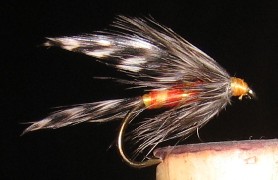 .. The Quick -N-Easy is one of those flies that makes many a fly fisher cringe. It is gaudy, flashy, big, and effective. It is famous for its spectacular refusals, and that's it's purpose. Tie it on early and then fish the fly that the fish are taking. This will show you that there are really fish in the water, and it may even catch one or two. Sizes: 8 - 14.
.. The Quick -N-Easy is one of those flies that makes many a fly fisher cringe. It is gaudy, flashy, big, and effective. It is famous for its spectacular refusals, and that's it's purpose. Tie it on early and then fish the fly that the fish are taking. This will show you that there are really fish in the water, and it may even catch one or two. Sizes: 8 - 14.
 .. Hellifiknow: This pattern is reminiscent of the Black Nose Dace and Micky Finn patterns. It is useful when the water is murky and you need to get a bit of twinkle down deep. It's a Spring staple and often a 'what if ?' kind of fly for prospecting. Sizes 4 - 12.
.. Hellifiknow: This pattern is reminiscent of the Black Nose Dace and Micky Finn patterns. It is useful when the water is murky and you need to get a bit of twinkle down deep. It's a Spring staple and often a 'what if ?' kind of fly for prospecting. Sizes 4 - 12.
 .. Scarlet Ibis: We've carried this fly since the early 60's. Bit of color never hurts the old fly boxes. This traditional wet fly is one that we fish for fun. It may be taken for an egg, a flying saucer, a cowboy's bandanna, or "who knows ?" - but it takes a few fish every year. Sizes: 8 - 14.
.. Scarlet Ibis: We've carried this fly since the early 60's. Bit of color never hurts the old fly boxes. This traditional wet fly is one that we fish for fun. It may be taken for an egg, a flying saucer, a cowboy's bandanna, or "who knows ?" - but it takes a few fish every year. Sizes: 8 - 14. use for this time of year. The fish are very hungry and are grabbing all manner of flotsam from the water. Many of the neighbors are keeping fish to eat and the stomach contents of these fish are revealing - even surprising.
use for this time of year. The fish are very hungry and are grabbing all manner of flotsam from the water. Many of the neighbors are keeping fish to eat and the stomach contents of these fish are revealing - even surprising.
 .. Although trout are frequently selective, they are always opportunistic feeders and their stomach contents reflect the food, (trout perception,) in the water column. This time of year the water column is full of vegetal detritus, suspended inorganics, and even some digestible items. The trout eat it all: small twigs, spent caddis cases, small stones, moss, collar buttons, bug bits, etc.
.. Although trout are frequently selective, they are always opportunistic feeders and their stomach contents reflect the food, (trout perception,) in the water column. This time of year the water column is full of vegetal detritus, suspended inorganics, and even some digestible items. The trout eat it all: small twigs, spent caddis cases, small stones, moss, collar buttons, bug bits, etc.
 .. Any fly that approximates any of these things will probably be sampled by hungry trout. And, it's a good bet that there is a chewed-up nymph in your fly box that is going to work just fine. Right now the most attractive "bits" are best simulated by Pheasant Tail Nymph, Yellowstone Badger Nymph, Brown San Juan Worm, and black Woolly Worm.
.. Any fly that approximates any of these things will probably be sampled by hungry trout. And, it's a good bet that there is a chewed-up nymph in your fly box that is going to work just fine. Right now the most attractive "bits" are best simulated by Pheasant Tail Nymph, Yellowstone Badger Nymph, Brown San Juan Worm, and black Woolly Worm.  Sizes on the smallish side: 12 -18.
.. Hebgen Lake is fishing very well and any place near the edge of the ice will produce. The tailwater fishery below Hebgen Dam is beginning to show spawning activity in the shallows - DON'T WADE! Fish these sections from the shore, or don't fish at all. There are some excellent deep runs and pools that are easily fished from the shore -- after all, Spey casting and roll casting are good for the soul. The Plunge Pool Run & Discharge Riffles, (see map,) are excellent spots for a deep dredged Woolly Worm or San Juan Worm.
.. Quake Lake is beginning to draw the neighbors as the ice recedes and breaks up. The lower sections of Awkward Bend and Long Riffle are holding excellent fish, (to 20",) and a slow drift - down deep - with a Pheasant Tail or Yellowstone Badger will produce some 'quick grabs.' These takes are of the tentative variety and it takes a great deal of skill and some luck to hook the fish. It's been suggested that 50% of the fish that taste a nymph go unnoticed by the fly fisher - probably so. Below Choice Hole and into Estuary Glide
Sizes on the smallish side: 12 -18.
.. Hebgen Lake is fishing very well and any place near the edge of the ice will produce. The tailwater fishery below Hebgen Dam is beginning to show spawning activity in the shallows - DON'T WADE! Fish these sections from the shore, or don't fish at all. There are some excellent deep runs and pools that are easily fished from the shore -- after all, Spey casting and roll casting are good for the soul. The Plunge Pool Run & Discharge Riffles, (see map,) are excellent spots for a deep dredged Woolly Worm or San Juan Worm.
.. Quake Lake is beginning to draw the neighbors as the ice recedes and breaks up. The lower sections of Awkward Bend and Long Riffle are holding excellent fish, (to 20",) and a slow drift - down deep - with a Pheasant Tail or Yellowstone Badger will produce some 'quick grabs.' These takes are of the tentative variety and it takes a great deal of skill and some luck to hook the fish. It's been suggested that 50% of the fish that taste a nymph go unnoticed by the fly fisher - probably so. Below Choice Hole and into Estuary Glide  there are still pods of trout. These fish may come to the surface for a well greased Woolly Worm, (size 12 - 16,) or one that is just below the surface. If your casting skills are up to it try a 5' leader: the takes are gently and quick.
.. The Madison River below McAtee bridge is in perfect shape right now and wading is a joy in the current low flows - guaranteed not to last for long. Some caddis are making an appearance and the appropriate sized Pheasant Tail or Yellowstone Badger will produce good times and dances.
there are still pods of trout. These fish may come to the surface for a well greased Woolly Worm, (size 12 - 16,) or one that is just below the surface. If your casting skills are up to it try a 5' leader: the takes are gently and quick.
.. The Madison River below McAtee bridge is in perfect shape right now and wading is a joy in the current low flows - guaranteed not to last for long. Some caddis are making an appearance and the appropriate sized Pheasant Tail or Yellowstone Badger will produce good times and dances.
 ..Some of the neighbors are willing to drive to the 'big water' and are fishing their favorite Golden Stone Flies and "Big Black Uglies" - and catching fish. There are even a few brave souls moving into the deep water and 'tight-lining' a streamer. This is a good way to coax some hogs from under the banks. They move just far enough away from the bank to avoid spooking the fish: then, cast way upstream from the target, and as the streamer approaches the 'hide' tighten the line and bend forward to let the fly move into position -- back strip a bit and allow the fly to 'swim' to the surface -- hold on!
..Some of the neighbors are willing to drive to the 'big water' and are fishing their favorite Golden Stone Flies and "Big Black Uglies" - and catching fish. There are even a few brave souls moving into the deep water and 'tight-lining' a streamer. This is a good way to coax some hogs from under the banks. They move just far enough away from the bank to avoid spooking the fish: then, cast way upstream from the target, and as the streamer approaches the 'hide' tighten the line and bend forward to let the fly move into position -- back strip a bit and allow the fly to 'swim' to the surface -- hold on!